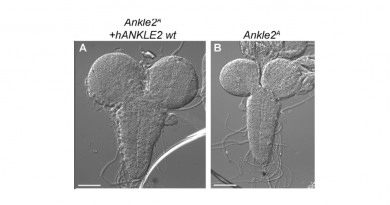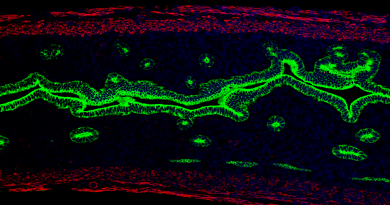Evolution of marine mammals to water converges in some genes
By Ruth SoRelle, M.P.H.
When marine mammals such as whales, dolphins, manatees and walruses moved from land to water, a series of physical abilities –– limbs adapted for swimming, less dense bones that make them more buoyant and a large store of oxygen relative to their body size – made it possible. Yet these animals made the transition from land to water millions of years apart.

Professor
Baylor College of Medicine Human Genome Sequencing Center
In a report that appears online in the journal Nature Genetics, an international consortium of researchers that includes those at Baylor College of Medicine looked at the genomes of these four marine mammals and compared them to their closest land kin. The genomes of the whale and dolphin were compared to that of the cow, the walrus to the dog and the manatee to the elephant.
“The Baylor College of Medicine Human Genome Sequencing Center had already done some sequencing of the dolphin and then refined the genome sequence further,” said Dr. Kim Worley, professor in the Baylor Human Genome Sequencing Center and an author of the project. The Baylor Center did the sequencing of the killer whale, dolphin and walrus and The Broad Institute of MIT and Harvard in Cambridge, Mass., sequenced the genome of the manatee. The phenomena of moving from land to water happened in the subclades (subgrouping) called Cetariodactyla(which includes whales, dolphins and cows) and Carnivora (which includes walruses and dogs)and Afrotheria (which includes manatees and elephants).
The marine mammals shared the traits needed to live in a marine environment, but they developed their traits separately – a process called convergent evolution.
“We were wondering what the genetic evidence for this convergent evolution was,” said Worley.
In their work, they found 191 genes likely to be associated with the move from land to sea that were selected during evolution across the four species, eight of these had undergone identical changes in the different lineages. Another seven genes had undergone identical changes but were believed to be involved in the land-sea shift in only a couple of the mammals.
The comparison of the genomes of the marine mammals has highlighted “parallel molecular changes in genes evolving under positive selections and putatively associated with independently evolved, adaptive phenotypic convergence,” the authors wrote. They also found widespread molecular convergence in the land animals.
“Our data therefore indicate that, although convergent phenotypic evolution can result from convergent molecular evolution, these cases are rare, and evolution more frequently makes use of different molecular pathways to reach the same phenotypic outcome,” the authors wrote.
“We found some positively selected genes that were selected on all lineages,” said Worley. “We found that there were parallel, non-synonymous changes in coding genes that occurred at the same amino acid site on more than one lineage. We also found similar history in the terrestrial animals.”
First authors on this paper include: Andrew D. Foote of the Natural History Museum of Denmark, University of Copenhagen, Denmark; Yue Liu of the Baylor College of Medicine Human Genome Sequencing Center in Houston; Gregg W. C. Thomas of Indiana University in Bloomington; and Tomáš Vinař of Comenius University in Bratislava, Slovakia.
Others who took part in the work include: Jixin Deng, Shannon Dugan, Vandita Joshi, Ziad Khan, Christie Kovar, Sandra L. Lee, Xiang Qin, Jiaxin Qu, Donna M. Muzny and Richard A. Gibbs, all of Baylor; Jessica Alföldi and Kerstin Lindblad-Toh of the Broad Institute at MIT and Harvard in Cambridge, Mass.; Cornelis Evan Elk of Dolfinarium Harderwijk, Harderwijk, The Netherlands; Margaret E. Hunter of the Sirenia Project, Southeast Ecological Science Center, U.S. Geological Survey in Gainesville, Florida; Annalaura Mancia of the Marine Biomedicine and Environmental Science Center, Medical University of South Carolina, Charleston, South Carolina; Rasmus Nielsen of Center for Theoretical Evolutionary Genomics, University of California, Berkeley, Berkeley, Calif.; Brian J Raney of Center for Biomolecular Science and Engineering, University of California Santa Cruz, Santa Cruz, Calif.; Nagarjun Vijay and Jochen B. W. Wolf of department of evolutionary biology, Evolutionary Biology Centre, Uppsala University, Uppsala, Sweden; Matthew W Hahn of department of biology, Indiana University, Bloomington, Indiana; and M. Thomas P. Gilbert of Trace and Environmental DNA Laboratory, department of environment and agriculture, Curtin University, Perth, Western Australia, Australia.
Funding for The Marine Mammals Genome Project came from the National Human Genome Research Institute Grant U54 HG003273 (R.A.G.) for the dolphin, walrus and killer whale and Grant U54 HG003067-08 for the manatee (K.L.-T. and J.A.), with additional funding from Grant DNRF94 for the walrus and killer whale (M.T.P.G.) and European Union IEF Grant KWAF10 (A.D.F.). A.D.F. was supported by a Marie Curie IEF KWAF10 and a Lawski Foundation fellowship, and T.V. was supported by grants 1/0719/14 and 1/1085/12 from the VEGA grant agency.



